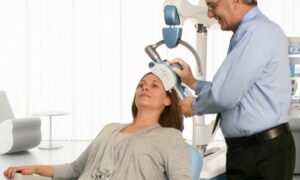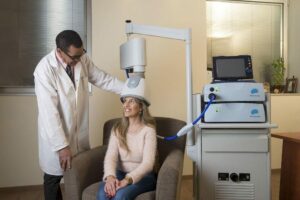If you have OCD, you know that intrusive thoughts and compulsive behaviors can be debilitating. You may have tried a number of treatments, such as medication and therapy, but they haven’t helped enough. You may be wondering if transcranial magnetic stimulation is right for you. In this blog post, we will discuss what TMS is, how it works, and the benefits and risks associated with it.
Contents
- 1 What Is Transcranial Magnetic Stimulation (TMS)?
- 2 How Does Transcranial Magnetic Stimulation For OCD Work?
- 3 What Techniques Does TMS Involve?
- 4 What Are The Benefits Of TMS For OCD?
- 5 What Are Some Risks And Side Effects?
- 6 Who Is Not Eligible For Transcranial Magnetic Stimulation For OCD?
- 7 Conclusion
What Is Transcranial Magnetic Stimulation (TMS)?
 Transcranial Magnetic Stimulation (TMS) is a non-invasive procedure used to stimulate nerve cells in the brain. It uses magnetic fields to send electrical signals directly into specific areas of the brain by passing an electric current through a small coil placed on the scalp. This stimulation can help treat certain medical conditions, such as depression, anxiety, obsessive-compulsive disorder, and Parkinson’s disease.
Transcranial Magnetic Stimulation (TMS) is a non-invasive procedure used to stimulate nerve cells in the brain. It uses magnetic fields to send electrical signals directly into specific areas of the brain by passing an electric current through a small coil placed on the scalp. This stimulation can help treat certain medical conditions, such as depression, anxiety, obsessive-compulsive disorder, and Parkinson’s disease.
TMS is typically administered in a doctor’s office or clinic and can last between 20 minutes to an hour. It is usually done as part of an overall treatment plan tailored to individual needs. TMS for OCD is often performed in combination with other forms of treatment, such as cognitive-behavioral therapy and medication.
TMS is generally considered safe and well-tolerated. However, if you are considering using this method, it is important to discuss the potential benefits and risks with your doctor. It may offer relief from symptoms when other methods don’t work for you.
How Does Transcranial Magnetic Stimulation For OCD Work?
Transcranial magnetic stimulation (TMS) is a relatively new and non-invasive treatment for OCD. TMS uses electromagnetic coils placed on the scalp to send pulses of energy into certain areas of the brain that are associated with OCD symptoms. This helps to stimulate and activate these areas, modulating their activity levels in order to reduce symptoms of OCD.
The patient is typically seated in a comfortable chair and the technician will place an electromagnetic coil on the scalp, over the area that needs to be stimulated. The patient is then given a mild electric shock which can cause some discomfort but is generally not painful. The pulses are administered for around 20 minutes at a time and repeated up to five times a week for several months.
The results of TMS have been promising, with some patients reporting significant improvements in their symptoms after just a few weeks of treatment. However, it is important to note that while TMS may be effective in reducing symptoms of OCD, it is not a cure. Most patients will still require ongoing therapy and medications to help manage their symptoms. Additionally, the effects of TMS may not be permanent and may need to be repeated in order to maintain results.
What Techniques Does TMS Involve?
Transcranial magnetic stimulation is a process of delivering magnetic pulses to the brain that are used to stimulate neuron activity. This stimulation is believed to help the brain regulate its own electrical signals, which can help balance and improve moods.
If we talk about the techniques involved in TMS, include:
- Repetitive transcranial magnetic stimulation (rTMS)
- Deep transcranial magnetic stimulation (dTMS)
rTMS is a technique of applying repeated, rapidly alternating pulses of magnetic fields to the surface of the head. This produces electric currents that are thought to stimulate nerve cells within certain regions of the brain. This type of TMS procedure is generally used to treat depression or other mental health conditions.
dTMS is a technique that involves the placement of coils directly on the scalp for a longer duration period. The coil generates strong magnetic fields that penetrate deep into the brain, stimulating deeper regions of the brain responsible for mood control. This type of TMS is used to treat more severe depression and anxiety-related conditions, including obsessive-compulsive disorder (OCD).
TMS is a safe, noninvasive procedure with minimal side effects. It is important to work with a trained healthcare provider to ensure that any TMS procedure is appropriately monitored and adjusted if needed.
What Are The Benefits Of TMS For OCD?
 This is an important question to ask because there are many potential benefits associated with TMS for OCD. Some of the common ones are listed below:
This is an important question to ask because there are many potential benefits associated with TMS for OCD. Some of the common ones are listed below:
- TMS is a non-invasive treatment option, meaning there are no needles or medication involved. This makes it an attractive choice for those with OCD who may not be comfortable with more invasive treatments.
- It has been found to be effective in reducing the symptoms of OCD, including distressing thoughts and behaviors.
- It can help to reduce stress and anxiety related to OCD, allowing individuals to better manage their symptoms.
- TMS is often used in combination with other treatments such as cognitive-behavioral therapy (CBT), providing added support for those dealing with OCD.
- It may be especially beneficial for those who have not responded well to other treatments for OCD.
- TMS has been found to be safe and generally well tolerated by those who use it.
Overall, TMS can provide a valuable treatment option for those with OCD. By providing relief from the symptoms of OCD, individuals are better able to manage their disorder and lead happier healthier lives. So, do not hesitate to speak with a medical professional to learn more about TMS and whether it could be right for you.
What Are Some Risks And Side Effects?
Transcranial magnetic stimulation OCD treatment is generally considered to be safe. It has been in use since the 1980s and there have not been any reports of serious adverse effects associated with its use.
However, it can cause some mild side effects such as:
- Headache
- Scalp discomfort or pain
- Tingling sensation in the head
- Dizziness
- Lightheadedness
- Nausea
- Fatigue
- Changes in vision or hearing
It is also important to note that the long-term effects of TMS are not well understood. Therefore, it is important to discuss with your doctor any potential risks before starting treatment. Other serious risks that have been associated with TMS include seizures and skin burns.
Therefore, it is important to ensure you are working with a qualified clinician who is using the appropriate safety equipment when administering the treatment. Otherwise, the risks may outweigh the potential benefits.
Who Is Not Eligible For Transcranial Magnetic Stimulation For OCD?
 As the effectiveness of TMS for OCD is still being studied and refined, there are certain criteria that must be met in order to be eligible for the treatment. There are some people with certain medical conditions who are not recommended for this treatment.
As the effectiveness of TMS for OCD is still being studied and refined, there are certain criteria that must be met in order to be eligible for the treatment. There are some people with certain medical conditions who are not recommended for this treatment.
Those conditions can be:
- An implanted medical device, like a pacemaker or cochlear implant
- A history of seizures in the last 5 years
- Pregnancy
- Metal implants in the head, such as an aneurysm clip
- Head injuries or skull defects
- Certain medications that cannot be discontinued, such as lithium and clozapine
- Any mental illness other than OCD that could interfere with the treatment
Additionally, individuals under 18 years of age are not typically eligible for this therapy. It is important to talk to your doctor to determine if you are a good candidate for TMS and to discuss any concerns or questions.
Transcranial Magnetic Stimulation is not typically recommended if other treatments such as psychotherapy and medications have been unsuccessful in addressing the symptoms of OCD. The best way to know if TMS is right for you is to talk with your doctor.
Conclusion
In conclusion, Transcranial Magnetic Stimulation for OCD can provide a safe and effective treatment option for those who have been unresponsive to traditional medications and therapies. With further research, this technology may become the go-to choice of treatment for OCD. It is important, however, to note that successful TMS therapy requires careful monitoring by a professional practitioner in order to ensure proper treatment and outcomes.
Don’t hesitate to contact us immediately for more information! OCD is a mental health disorder characterized by obsessions and compulsions. Contact us today if you have any queries regarding OCD treatment, or ERP therapy the experienced therapists at OCDMantra can help: Book a trial OCD therapy session


